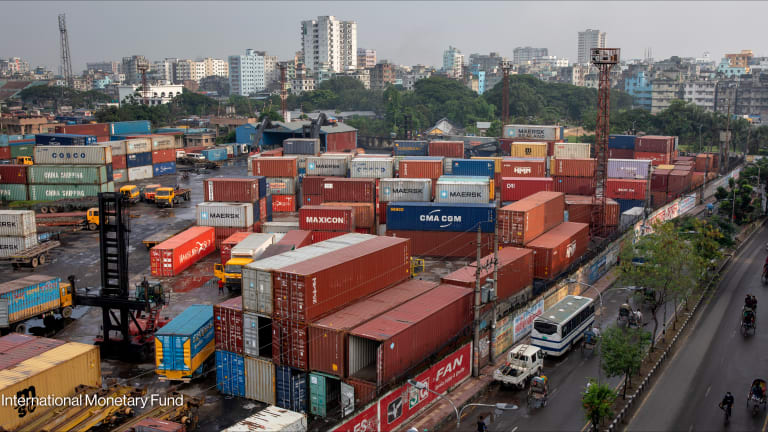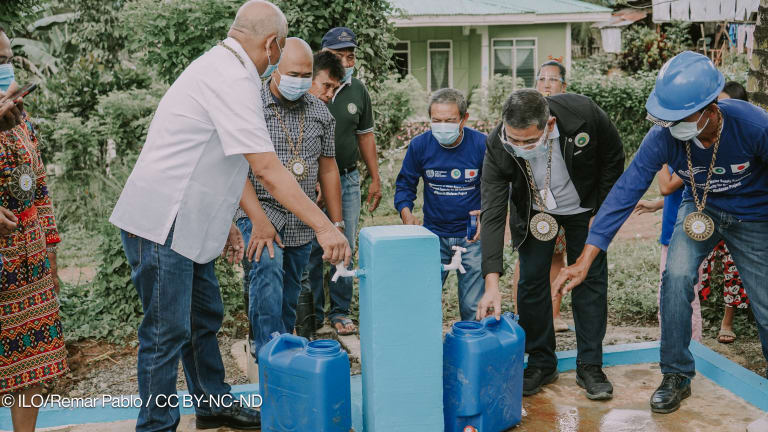How much aid goes to Myanmar?
Despite a recent surge in donor funding to Myanmar, foreign aid hasn't translated to equitable poverty reduction, Devex has found. We took a closer look into the data to see how much aid goes into each of the country's regions, states and cities.
At Myanmar’s recently concluded development cooperation forum, Wah Wah Maung, deputy director general of Myanmar’s Ministry of National Planning and Economic Development, expressed hopes that donors would support government efforts to promote better aid management and improved information sharing — two key principles that would keep development assistance in check for what is increasingly becoming the world’s donor darling. The march of donors to Myanmar is reflected in the amount of aid committed and disbursed to the once-closed country. In 2013, the latest year for which official figures from the Organization for Economic Cooperation and Development are available, disbursements to Myanmar reached $4.5 billion — a 788 percent increase from the $504 million released to the country in 2012. Poverty incidence within the country, however, is a little less straightforward. In a paper written for the U.N. Development Program, Stephan Schmitt-Degenhardt, a policy specialist, noted that while Myanmar managed to lower the poverty incidence between 2005 and 2010 from 29.6 percent to 22.7 percent — or 7 percentage points — there was apparent disparity of poverty reduction within the country. During the same period, poverty incidence decreased in almost all states and regions. But in Ayeyarwady, Kayin, Rakhine and Yangon, poverty actually worsened. Ayeyarwady, which was heavily battered by cyclone Nargis in 2008, and Rakhine, which has long been one of Myanmar’s poorest states, were even considered underperformers. “The development potentials are also very heterogeneous among regions and states … but none of them seems to have a high level of unviability for reducing poverty and promotion of inclusive growth,” Schmitt-Degenhardt wrote. Mohinga — Myanmar’s new aid information management system whose name, which denotes a rice noodle and fish soup that is part of Myanmar cuisine, reflects the aim of local ownership, according to the European Delegation to Myanmar — shows a clear, albeit still incomplete, picture of just how much assistance is going to the country’s states and regions. Below, we take a closer look at how much aid is going to each of Myanmar’s regions, states and cities. Naypyitaw While most of the Naypyitaw projects are being implemented, Myanmar’s capital has the least percentage of committed aid disbursed. With $4.2 million worth of projects in the pipeline, commitments in Naypyitaw are centered on agriculture ($10.5 million). India, which has $8.3 million in commitments, is the donor with the largest commitments to Naypyitaw. Mandalay In Mandalay, Japan is the largest donor, with $220.6 million in commitments. Most of the projects in Mandalay involve transport ($192.1 million), agriculture ($73.5 million) and energy generation and supply ($60 million). Twenty projects are being implemented, while eight are in the pipeline. Yangon Transport ($271.1 million) and water and sanitation ($227.5 million) are the two sectors with the highest value of commitments in Yangon. At $49 million, assistance for developing Yangon’s banking industry also makes up a significant part of commitments. Dwarfing the U.S. Agency for International Development and the Asian Development Bank, each with around $60 million in commitments, Japan is the largest donor, with $627.5 million worth of commitments. Tanintharyi region USAID ($40 million) is the largest donor in Tanintharyi, which had one of the highest incidences of both general and food poverty in ADB’s 2009-2010 Integrated Household Living Conditions Survey. ADB is the second top donor, with $12 million in commitments. Health ($18.4 million), food aid ($15.6 million) and agriculture ($12 million) are the main sectors in which commitments are concentrated. Shan state In Shan, where most locals work as farmers, agriculture ($39 million) is the sector with the largest commitments. Food aid ($15.6 million) and humanitarian aid ($12.5 million) also figure prominently among donors’ priorities in Shan, where fighting between the army and rebels from the Kokang, an ethnic Han group from the northern part of the state, has forced thousands of civilians to flee. USAID ($68.2 million) and Germany ($48 million) are the two main donors in Shan. Sagaing region UNDP’s paper on regional poverty in Myanmar identified drought as one of the problems that poor farmers face in Sagaing. Recognizing the importance of agriculture in the region, donors have committed most of their aid to this sector, at $62.7 million. USAID and ADB, meanwhile, are the two top donors in Sagaing. Rakhine state In Rakhine, ethnic violence against the Muslim Rohingya minority led donors to commit heavily to humanitarian aid ($15.4 million). Japan, with $24.6 million in commitments, is the largest donor. All projects in the state are in the implementation, completion or post-completion stages. Mon state Past conflict between the government and the New Mon State Party, which has resisted the government since 1949, has displaced many locals, most of them Mon people, in the state. Health ($28.4 million), secondary education ($21.2 million), and food aid ($15.6 million) are the main sectors for aid commitments. USAID, the Swiss Agency for Development Cooperation and ADB are the three largest donors in the state. Magway region Agriculture ($69.5 million) is the primary sector for aid commitments in Magway, which according to UNDP’s regional survey suffers the highest crop losses from calamities. USAID and ADB are the two top donors, with $85 million and $72 million, respectively, in commitments. Kayin state Home to the Karen people, who have been pushing for greater autonomy since 1949, Kayin has most of its donor commitments centered on health ($29.9 million), secondary education ($21.2 million) and food aid ($15.6 million). USAID ($41.2 million), SDC ($21.2 million) and ADB ($10.1 million) are the donors with the most commitments. Kayah state In Kayah, where a 2012 cease-fire between the government and armed groups left a temporary peace, most of the commitments are channeled toward health ($48.1 million), agriculture ($27.5 million) and food aid ($15.6 million). USAID is the largest donor, with $90.5 million in commitments. Kachin state Since 1961, the Kachin ethnic group has fought for greater autonomy in Myanmar. Several cease-fire agreements have been signed by the Kachin Independence Army and the government, only for these to crumble and for fighting to resume. This has meant that health (28.4 million) and humanitarian aid ($15.4 million) are the main focus of donor commitments in the state. UNICEF ($29.8 million), Japan ($17.6 million) and the European Union ($5.1 million) are the largest donors. Chin state Recording the highest poverty incidence in the IHLCS, Chin has most of its donor commitments focused on multisector aid ($151 million). The World Bank ($151 million) is the state’s largest donor, followed by India ($76.3 million) and SDC ($21.2 million). All projects are in various stages of implementation, with no new ones in the pipeline. Bago region Japan ($219.9 million) is the biggest donor in Bago, where commitments are concentrated in the transport sector ($192.1 million). UNDP’s study of regional poverty in Myanmar noted that high prices in the region point to inefficiently functioning local markets — discrepancies that shouldn’t be present given Bago’s proximity to Yangon. Ayeyarwady region According to the IHLCS, based on population, the region contributed the most to national poverty in 2010. Transport ($80 million) is the primary focus of donor commitments, and most of the projects are in the implementation stage. ADB, with $92 million in commitments, is the main donor in the region. Check out more funding trends analyses online, and subscribe to Money Matters to receive the latest contract award and shortlist announcements, and procurement and fundraising news.
At Myanmar’s recently concluded development cooperation forum, Wah Wah Maung, deputy director general of Myanmar’s Ministry of National Planning and Economic Development, expressed hopes that donors would support government efforts to promote better aid management and improved information sharing — two key principles that would keep development assistance in check for what is increasingly becoming the world’s donor darling.
The march of donors to Myanmar is reflected in the amount of aid committed and disbursed to the once-closed country. In 2013, the latest year for which official figures from the Organization for Economic Cooperation and Development are available, disbursements to Myanmar reached $4.5 billion — a 788 percent increase from the $504 million released to the country in 2012.
Poverty incidence within the country, however, is a little less straightforward.
This story is forDevex Promembers
Unlock this story now with a 15-day free trial of Devex Pro.
With a Devex Pro subscription you'll get access to deeper analysis and exclusive insights from our reporters and analysts.
Start my free trialRequest a group subscription Printing articles to share with others is a breach of our terms and conditions and copyright policy. Please use the sharing options on the left side of the article. Devex Pro members may share up to 10 articles per month using the Pro share tool ( ).
Anna Patricia Valerio is a former Manila-based development analyst who focused on writing innovative, in-the-know content for senior executives in the international development community. Before joining Devex, Patricia wrote and edited business, technology and health stories for BusinessWorld, a Manila-based business newspaper.






